Get Organized Month: Paper Control–Open Book Exam
We’re coming to the end of our month-long Get Organized Month course on paper control. In our first semester, we reviewed the basics, including identifying and evaluating incoming papers (and the backlog), purging unnecessary papers, halting the influx of junk mail, credit card and marketing offers and other cluttery mail, and developing an initial system for paper management.
In our advanced semester, we offered up shredder wisdom and reviewed how to develop a digital system matched to your paper organizing system. And last week’s graduate course covered the vital topic of vital documents and creating a system for keeping you out of jail, out of unwarranted debt and off the terrorist watch list. (This advice was limited to proving identity and payment; if you’re actually a bad guy, you’re on your own.)
All of this leaves you prepared to take the open book test that is life–keeping you chaos-free in the paper department. There’s only one final lesson, with variations on a theme.
In general, I believe in filing systems using actual files. Whether you run a home business or the business of your home, papers stored vertically in file folders (in their myriad forms, from plain 1/3 cut manila folders and olive green hanging folders to brightly hued versions) give you the least expensive, most expansive, opportunity to organize your life. However, there’s a more important lesson to take than “files rule and vertical storage rocks”:
If you don’t like your system, you won’t commit to it.
Human beings are tricky; we’re not cookie cutter automatons. Some people can’t abide anything short of a Skittles “Taste the Rainbow” panoply of colors; others find the mere sight of filing cabinets to be distasteful. If you don’t like the aesthetics of your system, no matter how well it works in the abstract, you’re not going to faithfully use it. If you avoid the system, you’ll avoid the action, and your papers will continue to pile up around you. Soon your Paper Doll University diploma will be sandwiched between car wash coupons and your 1099s on the sticky kitchen counter. That won’t make anyone happy.
So, taking everything you’ve already learned in the prior coursework into account, there are variations to consider for each type of paper in your life:
REFERENCE PAPER/FILES
You’ve studied up and you know you have to have an organized way to keep your financial, legal, medical, household and personal reference files orderly so you can retrieve what you need at a moment’s notice. But the minute you read “filing”, you started to cringe.
Chance are, you don’t hate filing, just the ugly metal filing cabinets that remind you of your old corporate job or the principal’s office. There are any number of gorgeous alternatives to gunmetal grey cabinets. At one end of the design continuum, there are the colorful plastic milk crates file boxes; at the other, there are luxurious leather file boxes.
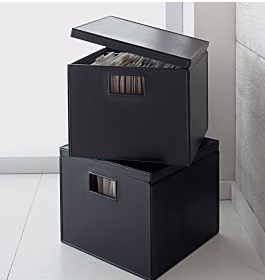
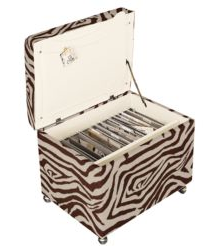
There are glorious filing cabinets designed to fit your office dcor, as well as filing-cabinet ottomans, baskets and boxes that range from quirky to CEO-chic. If you need to move your files from kitchen to home office, or home office to your studio, there are all manner of file carts for your pop-a-wheelie pleasure, like these from
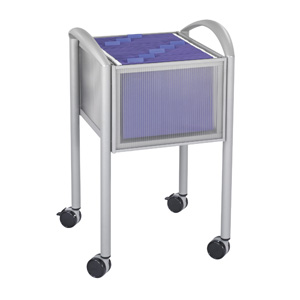 Safeco or
Safeco or 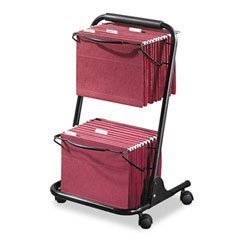 Rubbermaid.
Rubbermaid.
And what if you have a perfectly good filing cabinet that just bores you to tears? There’s always the DIY approach.
(For more filing container delights, I direct you to the blog of my favorite organizational product maven, the incomparable Jeri Dansky who has her finger on the pulse of form+function magnificence.)
Of course, there’s a popular alternative to using file folders altogether: the binder. As we’ve discussed in past posts, ringed binders are especially great for keeping track of financial data like banking and investment statements, as well as recipes.
A major advantage of storing reference materials in binders is that it makes it eminently portable. If you want to carry five years of retirement investment statements to your new financial planner, a binder is far easier to tote than an overfilled folders. (As with people, folders get unwieldy with too much tonnage.) For those concerned with aesthetics, there are some very attractive pre-made binder options out there; alternatively, the plastic front/back covers and spines of most binders let you quickly decorate them by inserting photos (…even a down stock market is cheerier if George Clooney’s looking back at you) or useful information (like metric conversions for the front of your recipe binder).
The main disadvantage of binders vs. folders is added labor. To walk your fingers along file tabs until you locate the correct file into which you drop a piece of paper takes mere seconds. However, punching holes (or placing a piece of paper in a plastic sheet protector) takes longer, making people less likely to file as they go. The more the paper clutter piles up (like dishes in the sink), the more forbidding the task seems.
INCOMING PAPER
Of course, before paper can ever be filed away (or acted upon), you need to figure out what it is, and to do that, it’s best to have all the paper that enters your house or office start off in one place. If all the new mail, receipts and papers get plopped down anywhere from the couch to the top of the microwave, your system will break down before it ever gets started.
The horizontal paper gathering device is better known by its more common name: the lowly in-tray. In-trays can be plastic, metal or mesh. A dishpan from the dollar store is as unbreakable as it is unremarkable, but is great when you’re teaching the tiniest members of your household how to put papers away without concern for damage. Standard trays run the gamut from utilitarian pieces from office supply stores
 to more eclectic options
to more eclectic options  at online specialty shops (like See Jane Work), and they can all run from single-story to skyscraper style, depending on your needs.
at online specialty shops (like See Jane Work), and they can all run from single-story to skyscraper style, depending on your needs.
If you’re short on flat space, incoming papers can also find a vertical home in containers as simple as those smoky plastic wall pockets outside your doctor’s examination rooms, to magnetic stainless steel and canvas options like these from the Container Store:
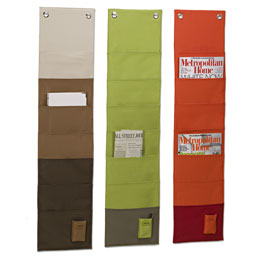
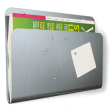 to decor-matching solutions suitable for the Colonel Mustard in the Library.
to decor-matching solutions suitable for the Colonel Mustard in the Library.
ACTION PAPER
Once papers enter your life and have been deemed worthy of avoiding the shredder, they either need be filed away (“sent home”) for reference or acted upon. Indeed, most of the paper clutter in which people drown are items that represent actions or tasks they must perform. Regular readers of this blog know how much I love tickler files
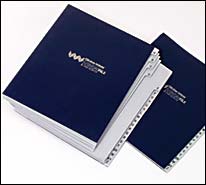
for prioritizing and easing the handling of action paper. (While I can’t say “I like them so much, I bought the company”, I can say I like them so much, I wrote a book about them!) There are multiple brands and styles of tickler files, from the portable accordion-style standard to the DIY-version you can make with 43 folders (31 for the days of the month, plus 12 for each individual month), which you can keep in a desk-top file box, either plain-jane plastic or fashion-forward. There are even vertical versions of tickler files to use a week at a time, like EZ-Pocket from OnlineOrganizing. 
(One caveat: Slotted wooden products 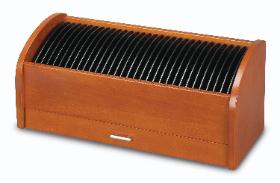 are designed for mail and are too small for action papers.)
are designed for mail and are too small for action papers.)
Not everyone is keen on tickler files, however, and some people prefer to create action folders (To Read, To Write, To Call, To Pay, etc.). Unlike reference files, which are best kept corralled away from the prime real estate, action files belong where you can see them…they just shouldn’t lay flat on the desktop. Open desktop file boxes 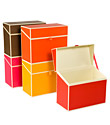 and file risers/sorters
and file risers/sorters 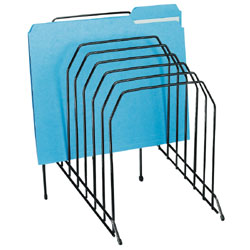 are perfect homes for these task-oriented files divided by category. (Get a riser that elevates each file progressively, like stadium seating at the movies.) However, as the these categories aren’t sorted or prioritized by date, be sure to schedule blocks of time on your calendar so your must-do items don’t languish in the folders.
are perfect homes for these task-oriented files divided by category. (Get a riser that elevates each file progressively, like stadium seating at the movies.) However, as the these categories aren’t sorted or prioritized by date, be sure to schedule blocks of time on your calendar so your must-do items don’t languish in the folders.
TRAVELING PAPER
In addition to dealing with the incoming, action and reference paper, there’s another kind of paper that straddles all of these categories–paper that you need when you’re moving through space, time and life. Paper Doll University’s extension courses have previously covered the systems and products for dealing with personal and business papers that travel when you do:
Mobile Mavens: Keeping the Personal Paper Portable When You’re Out and About
A Culinary Model for Successful Mobile Offices
Don’t forget to keep track of the papers you need for traveling. One of our readers commented last week about losing track of vital documents before traveling, and maintaining those documents while on the move is also always a concern. I advise:
1) As soon as you receive your travel confirmations (tickets, itineraries, car/hotel reservation confirmation numbers, etc.), make sure you have everything you need (including toll-free numbers). Now that e-tickets are the norm, it’s ridiculously easy to print two copies of your itinerary or receipt and no actual ticket/boarding information.
2) Next, print two copies (oh, the trees!) or email copies to a trusted friend (or two) who is always online and available in an emergency. If you are traveling with a partner, each should keep a copy of the other’s info; also, plan to keep an extra copy of your papers in your suitcase in the event your main copy is lost during your trip, after arriving at your destination.
3a) Put travel confirmations in a poly envelope  that seals with an elastic band or snap, preferably one that is translucent so that you can place your documents in the order in which you’ll need them. Move the flight itinerary facing out the front; after you’ve used your ticket, have your rental car or hotel reservations facing the back so you can read them without evening opening the envelope.
that seals with an elastic band or snap, preferably one that is translucent so that you can place your documents in the order in which you’ll need them. Move the flight itinerary facing out the front; after you’ve used your ticket, have your rental car or hotel reservations facing the back so you can read them without evening opening the envelope.
3b) Keep tickets in the poly envelope OR in a passport/ticket wallet. Faux-classy vinyl or leather portfolios allow you to keep your passport, ticket, other ID all snugly together when you’re traveling abroad.
4) Put the poly envelope in your tickler file for the day before you’re going to travel, so you can review your documents and travel times. If you don’t use a tickler, be sure to note in your calendar where you’ve placed your tickets and paperwork. (If your office isn’t yet organized, consider putting the paperwork in your carry-on bag, so you’ll see it when you start packing for your trip.)
5) When you return from your trip, empty the poly envelope and passport/ticket wallet as part of the unpacking process. Make sure your passport and various forms of ID go back to their permanent homes when their (and your) vacation is over.
Congratulations, Paper Doll University graduates! Go forth and master your paperwork!




Follow Me